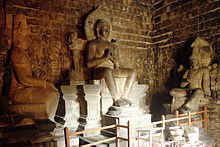- Mendut
-
Mendut 
General information Architectural style Buddhist candi Town or city near Magelang, Central Java Country Indonesia Coordinates 7°36′14″S 110°13′48″E / 7.604°S 110.23°E Completed circa early 9th century Design and construction Client Sailendra Mendut is a ninth century Buddhist temple, located in Mendut village, Mungkid sub-district, Magelang Regency, Central Java, Indonesia. The temple is located about three kilometres east from Borobudur. Mendut, Borobudur and Pawon, all of which are Buddhist temples, are located in one straight line. There is a mutual religious relationship between the three temples, although the exact ritual process is unknown.[1]
Contents
History
Built around early ninth century AD, Mendut is the oldest of the three temples including Pawon and Borobudur. The Karangtengah inscription, the temple was built and finished during the reign of King Indra of Sailendra dynasty. The inscription dated 824 AD mentioned that King Indra of Sailendra has built a sacred building named Venuvana which means "bamboo forest". Dutch archaeologist JG de Casparis has connected the temple mentioned in Karangtengah inscription with Mendut temple[citation needed].
In 1836 it was discovered as a ruins covered with bushes. The restoration of this temple was started at 1897 and it was finished at 1925. Some archaeologists who had conducted research on this temple were JG de Casparis, Theodoor van Erp, and Arisatya Yogaswara.
Architecture
The 26.4 metres tall temple is facing northwest. The stairs projecting from the northwest side square elevated base is adorned with Makara statue on each sides, the side of the stairwall carved with bas-relief of fable narrating the animal story of buddhist teaching. The square terrace surrounding the body of the temple was meant for pradakshina or circumambulating ritual, walking clockwise around the temple. The outer walls is adorned with bas-reliefs of Boddhisattvas (buddhist divinities), such as Avalokitesvara, Maitreya, Cunda, Ksitigarbha, Samantabhadra, Mahakarunika Avalokitesvara, Vajrapani, Manjusri, Akasagarbha, and Boddhisattvadevi Prajnaparamita among other buddhist figures. Originally the temple had two chambers, a small chamber in the front, and the large main chamber in the center. The roof and some parts of the front chamber walls are missing. The inner wall of front chamber is adorned with bas-relief of Hariti surrounds by children, Atavaka on the other side, Kalpataru, also groups of devatas divinities flying in heaven.
The main room housed three beautifully carved large stone statues. The three statues are the Buddhist main divinities revered in Mendut temple which can explain the spiritual purpose of the establishment of this temple. The 3 metres tall statue of Dhyani Buddha Vairocana was meant to liberate the devotees from the bodily karma, at the left is statue of Boddhisatva Avalokitesvara to liberate from the karma of speech, at the right is Boddhisatva Vajrapani to liberate from karma of thought. [2]
Today, during the full moon in May or June, Buddhists in Indonesia observe Vesak annual ritual by walking from Mendut passing through Pawon and ends at Borobudur.[3]
See also
References
- ^ J. L. Moens (1951). "Barabudur, Mendut en Pawon en hun onderlinge samenhang (Barabudur, Mendut and Pawon and their mutual relationship)". Tijdschrift voor de Indische Taai-, Land- en Volkenkunde (Het Bataviaasch Genootschap van Kunsten en Wetenschappen): 326–386. http://www.borobudur.tv/Barabudur_Mendut_Pawon.pdf. "trans. by Mark Long"
- ^ The information board at the Mendut Temple vicinity
- ^ "The Meaning of Procession". Waisak. Walubi (Buddhist Council of Indonesia). http://www.walubi.or.id/waisak/waisak_emakna_prosesi.shtml. Retrieved 2006-12-13.
External links
- Official site
- An Architectural Description of the Mendut Temple from Borobudur.TV
Buddhist temples in Indonesia Candi of Indonesia · Batujaya · Borobudur · Mendut · Muaro Jambi · Muara Takus · Kalasan · Pawon · Plaosan · Sari · Sewu
Wikimedia Foundation. 2010.




